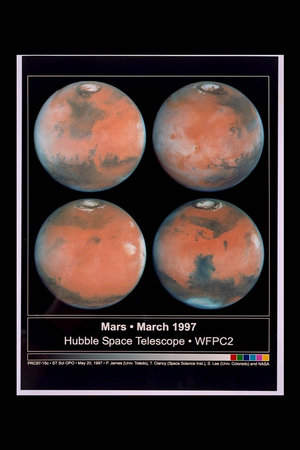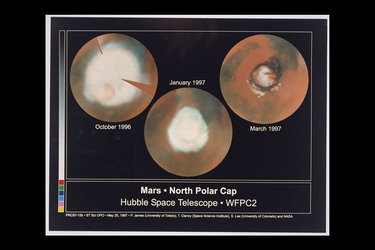

Comparison view of Mars cloud cover
These Mars images were taken by the Hubble Space Telescope just 2 weeks after Earth made its closest approach to the Red Planet during the 1997 opposition. They show Mars at a distance of 100 million kilometres; the resolution at the centre of the disk is 22 km/pixel. Both images were made with the Wide Field and Planetary Camera 2. The colour composite is constructed from three taken in red (673 nm), green (502 nm) and blue (410 nm). The right image, in blue light only, brings out details in the cloud structure and is remarkably similar to weather satellite pictures taken of Earth. A planetary-scale wave curls around the north pole, similar in behaviour to high latitude cold fronts that descend over North America and Europe during springtime. The picture was taken when Mars was near aphelion, its farthest point from the Sun. The faint sunlight results in cold atmospheric conditions which stimulate the formation of water ice clouds. The clouds themselves further reduce atmospheric temperatures. These images are centred at approximately 94° longitude and 23° N latitude (oriented with north up). The four largest Tharsis Montes (massive extinct volcanoes) are visible as dark spots extending through the clouds. The vast canyon system, Valles Marineris, stretches across the eastern (lower right) half of the image. It is early summer in the northern hemisphere, and the north polar cap has retreated to about 80° N latitude; the 'residual' summer cap, composed of water ice, is about one-third the size of the 'seasonal' winter cap, which consists mostly of carbondioxide frost condensed or the surface. The polar cap is surrounded by a 'sand sea' made up of dark sand dunes. A distinct belt of water-ice clouds extends over much of this hemisphere. [Image Date: 20-05-97] [97.06.002-003]





